Sir John Monash, Personal Files Book 2, 23 February - 31 March 1915, Part 13
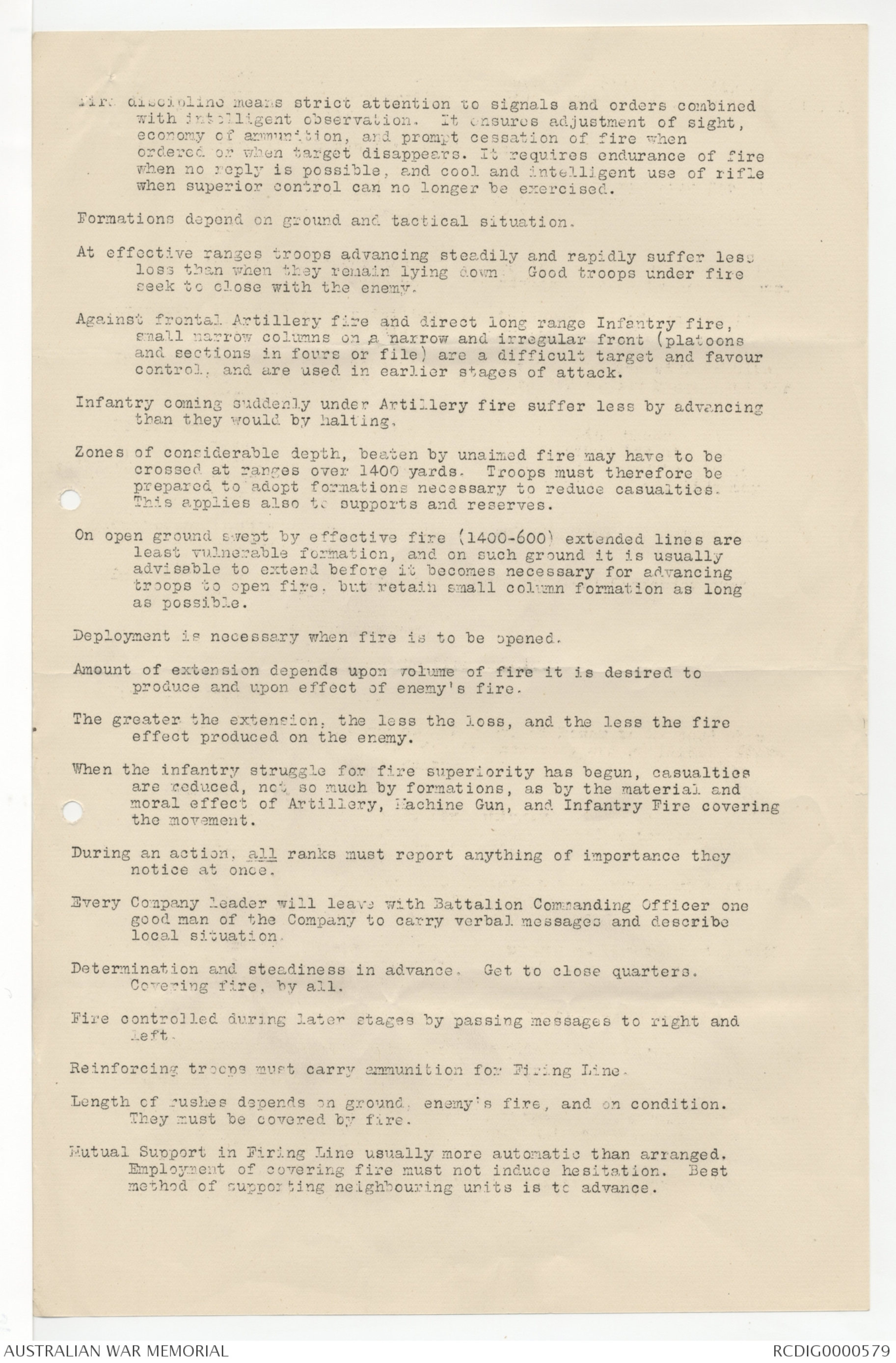
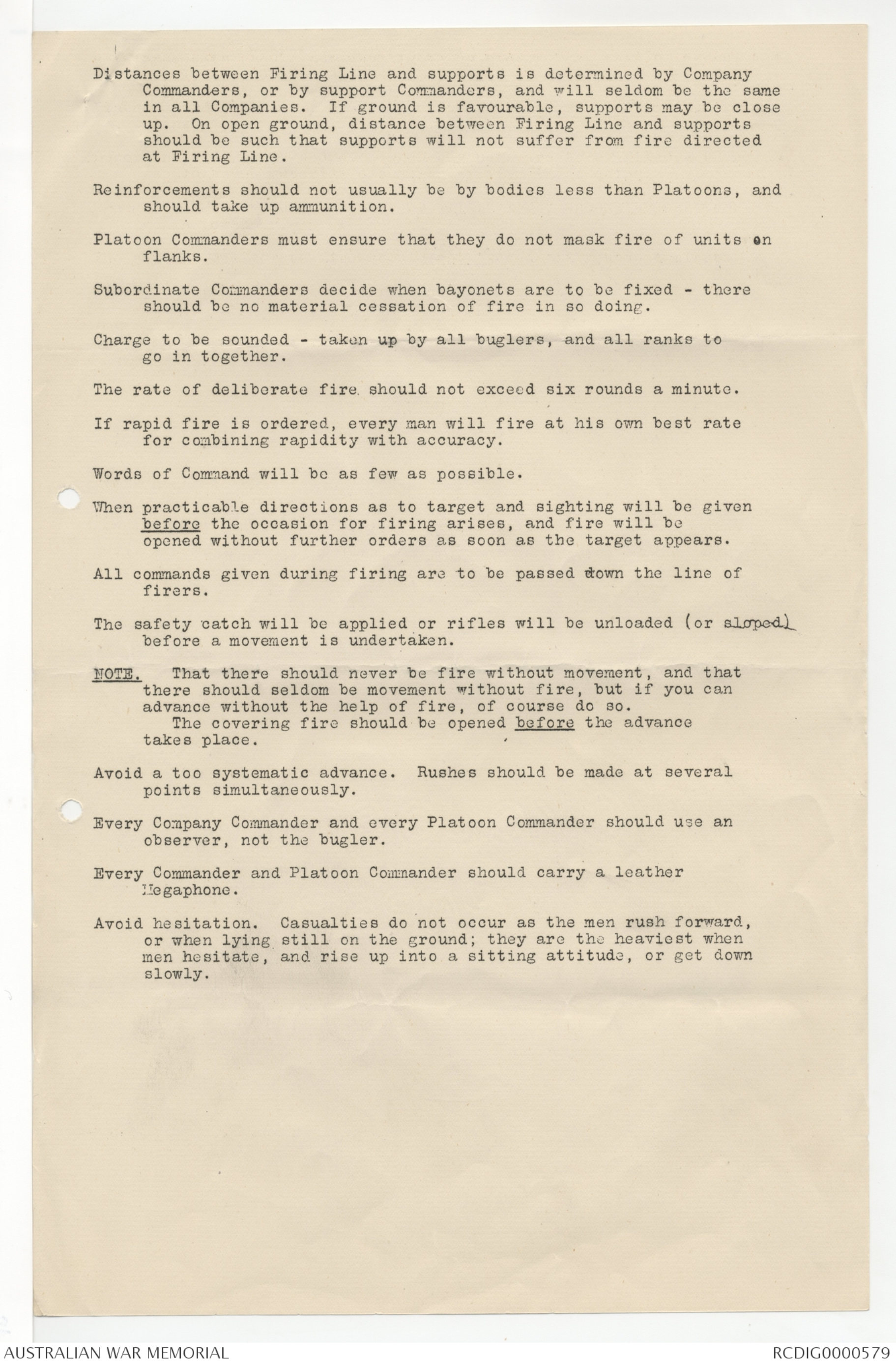
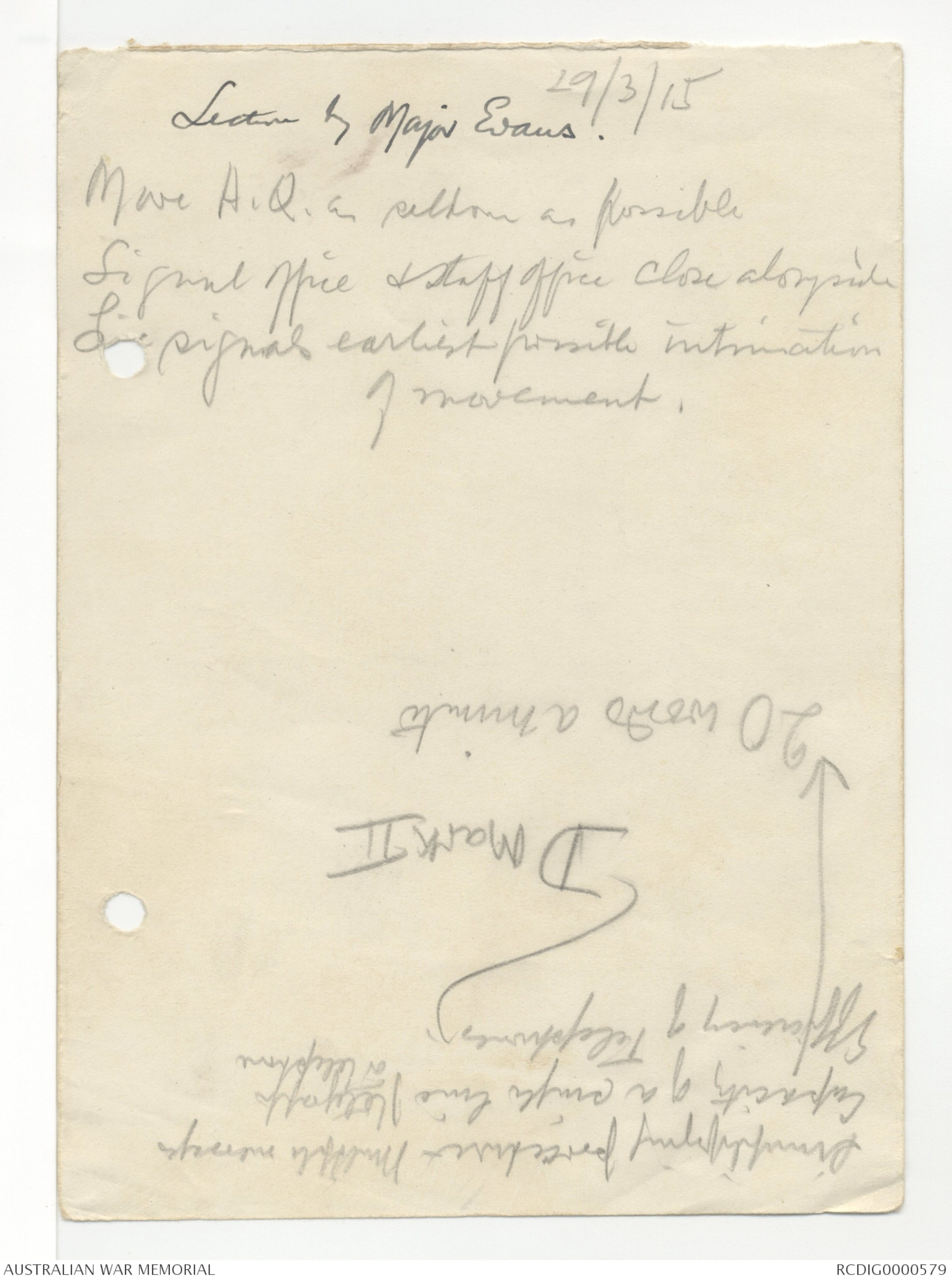
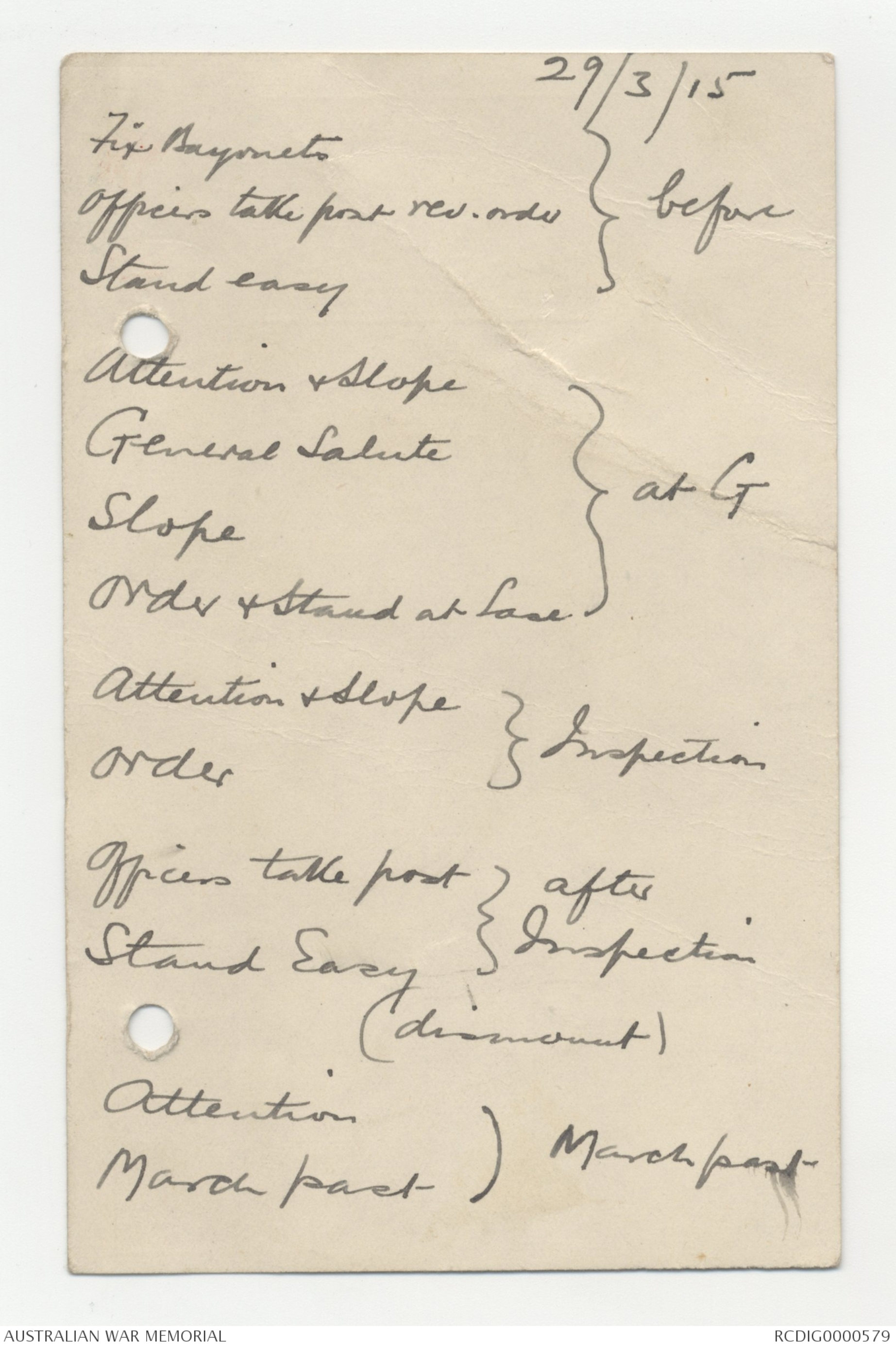
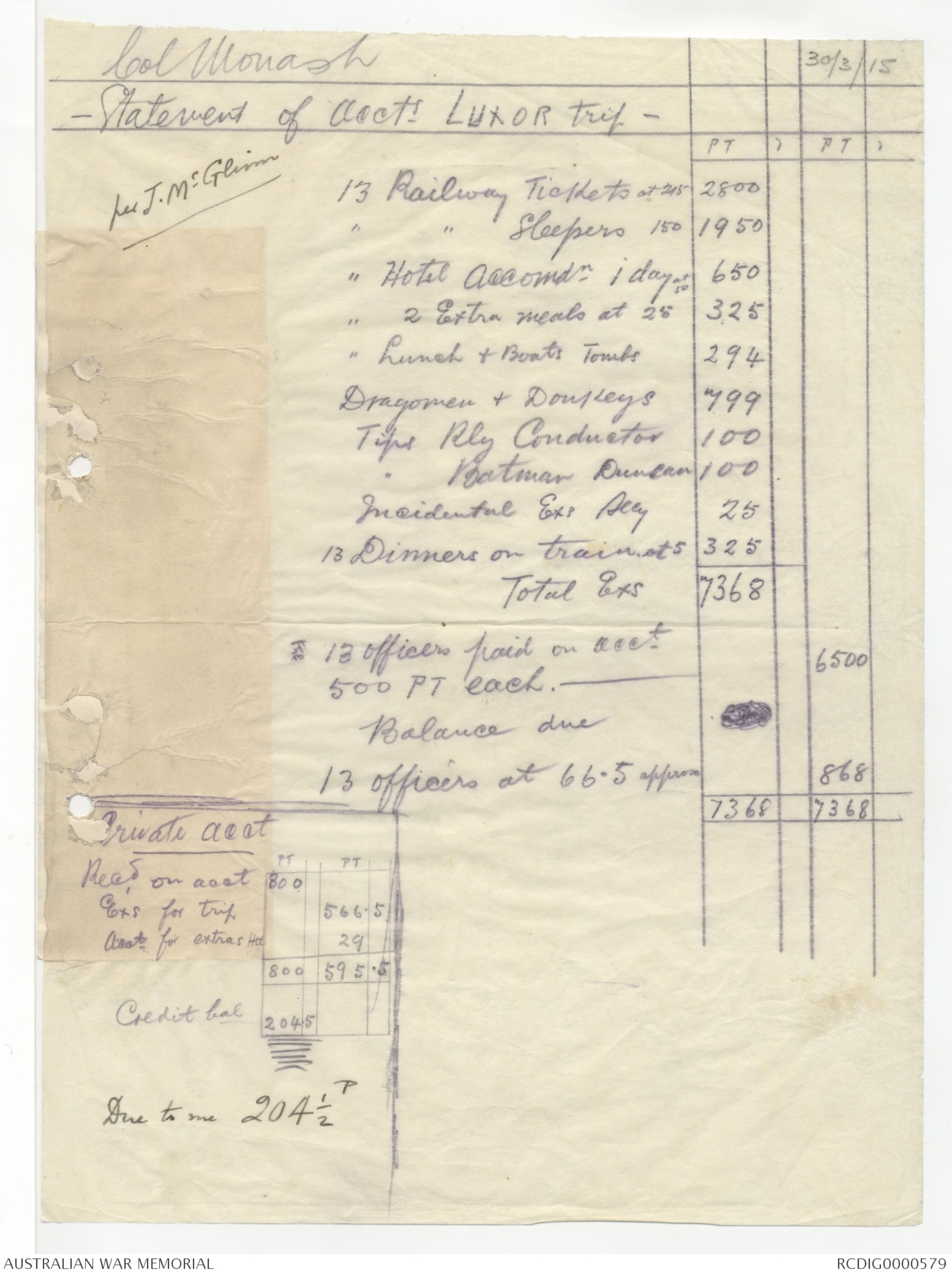
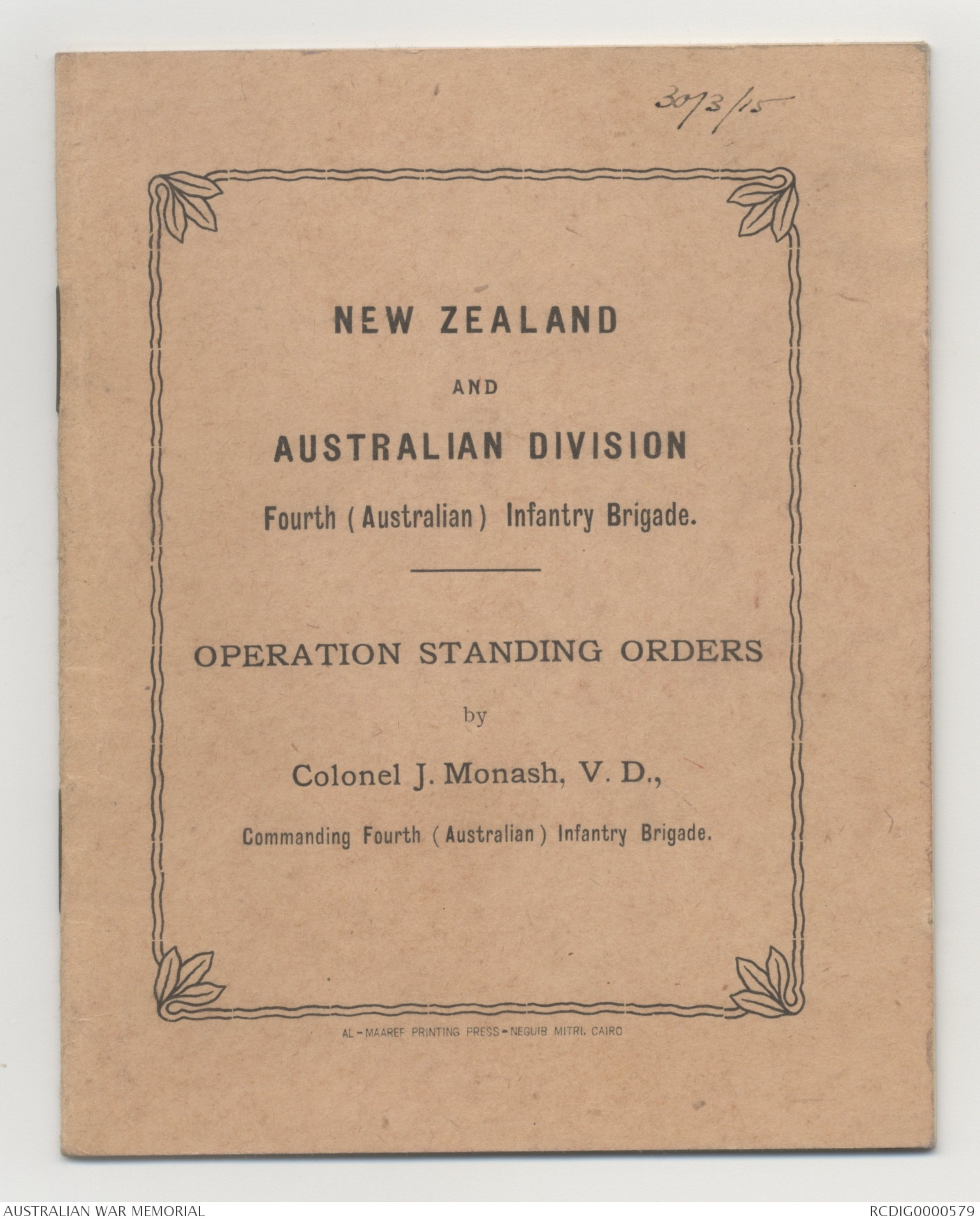
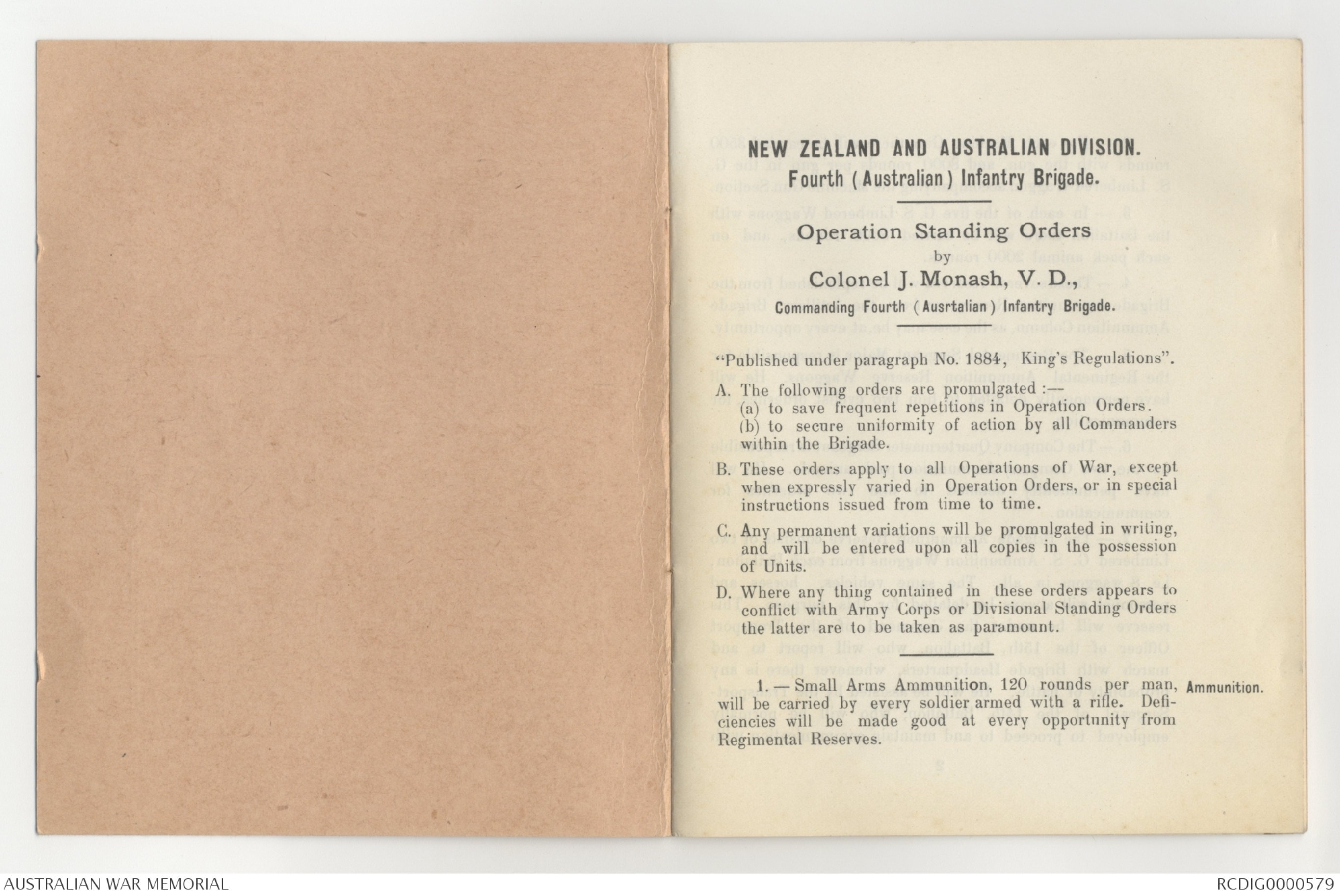
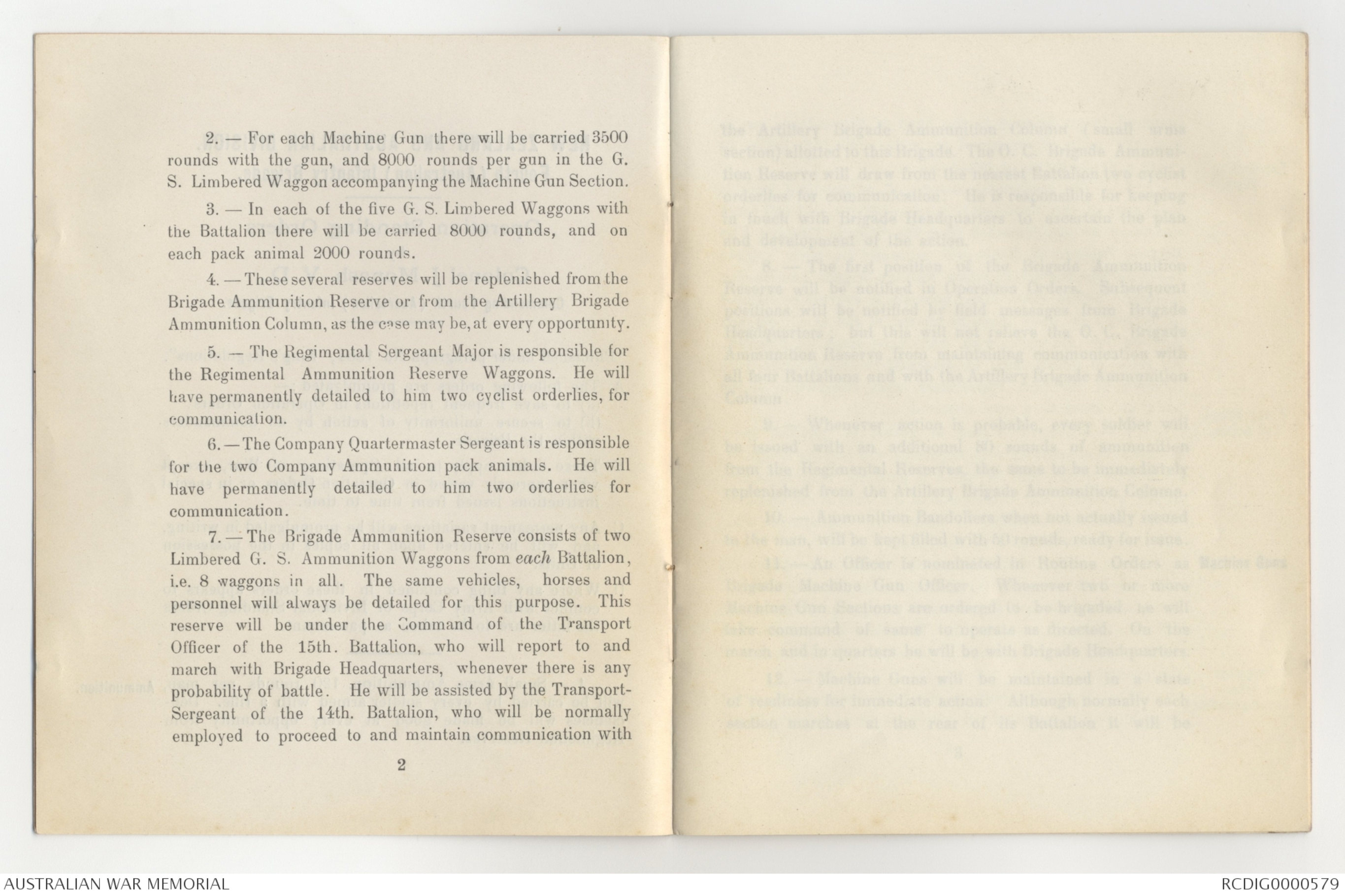
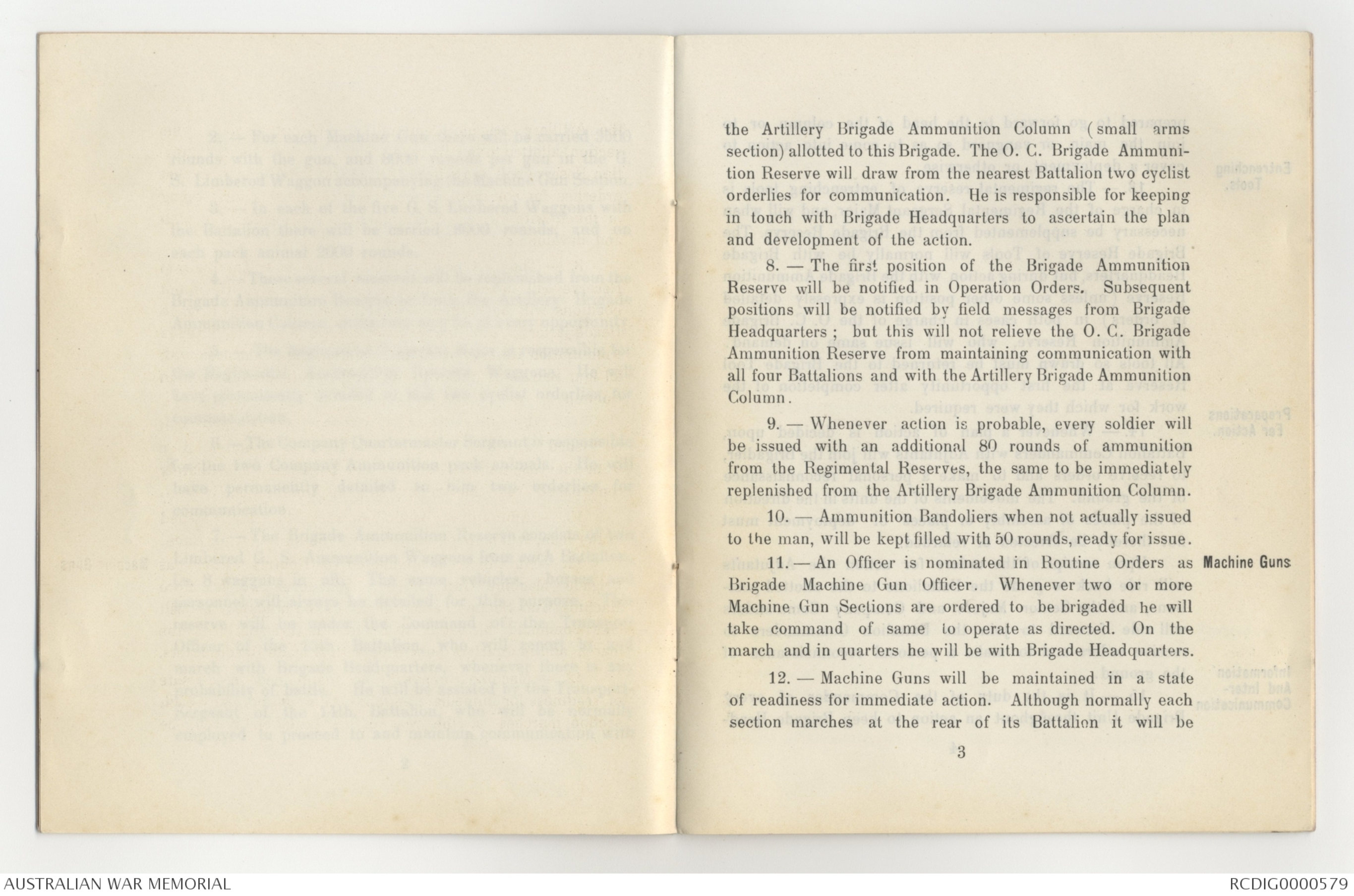
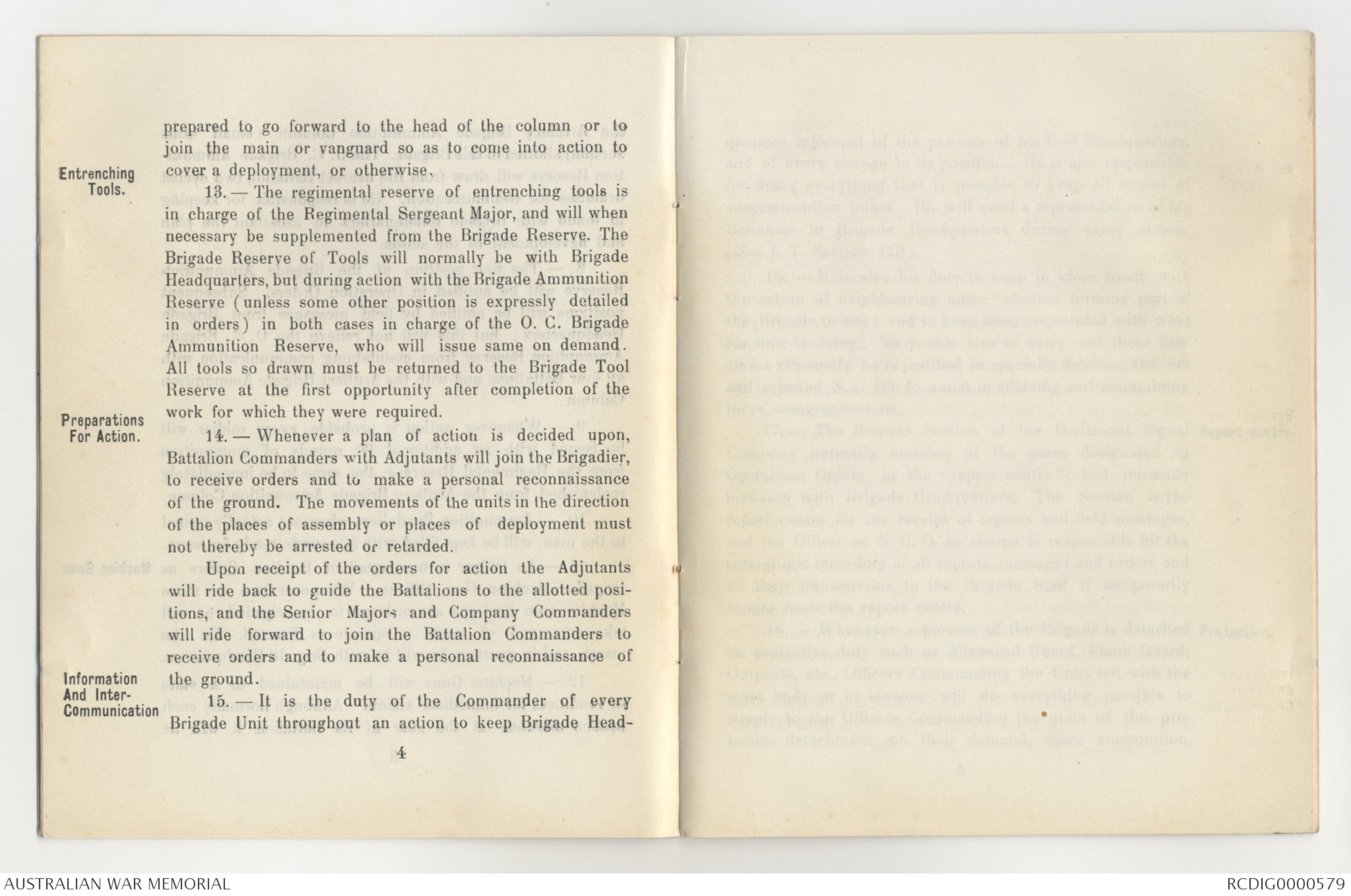
fire discipline means strict attention to signals and orders combined
with intelligent observation. It ensures adjustment of sight,
economy of ammunition, and prompt cessation of fire when
ordered or when target disappears. It requires endurance of fire
when no reply is possible, and cool and intelligent use of rifle
when superior control can no longer be exercised.
Formations depend on ground and tactical situation.
At effective ranges troops advancing steadily and rapidly suffer less
loss than when they remain lying down. Good troops under fire
seek to close with the enemy.
Against frontal Artillery fire and direct long range Infantry fire,
small narrow columns on a narrow and irregular front (platoons
and sections in fours or file) are a difficult target and favour
control, and are used in earlier stages of attack.
Infantry coming suddenly under Artillery fire suffer less by advancing
than they would by halting.
Zones of considerable depth, beaten by unaimed fire may have to be
crossed at ranges over 1400 yards. Troops must therefore be
prepared to adopt formations necessary to reduce casualties.
This applies also to supports and reserves.
On open ground swept by effective fire (1400-600) extended lines are
least vulnerable formation, and on such ground it is usually
advisable to extend before it becomes necessary for advancing
troops to open fire, but retain small column formation as long
as possible.
Deployment is necessary when fire is to be opened.
Amount of extension depends upon volume of fire it is desired to
produce and upon effect of enemy's fire.
The greater the extension, the less the loss, and the less the fire
effect produced on the enemy.
When the infantry struggle for fire superiority has begun, casualties
are reduced, not so much by formations, as by the material and
moral effect of Artillery, Machine Gun, and Infantry Fire covering
the movement.
During an action, all ranks must report anything of importance they
notice at once.
Every Company leader will leave, with Battalion Commanding Officer one
good man of the Company to carry verbal messages and describe
local situation.
Determination and steadiness in advance. Get to close quarters.
Covering fire, by all.
Fire controlled during later stages by passing messages to right and
left.
Reinforcing troops must carry ammunition for Firing Line.
Length of rushes depends on ground, enemy's fire, and on condition.
They must be covered by fire.
Mutual Support in Firing Line usually more automatic than arranged.
Employment of covering fire must not induce hesitation. Best
method of supporting neighbouring units is to advance.
Distances between Firing Line and supports is determined by Company
Commanders, or by support Commanders, and will seldom be the same
in all Companies. If ground is favourable, supports may be close
up. On open ground, distance between Firing Line and supports
should be such that supports will not suffer from fire directed
at Firing Line.
Reinforcements should not usually be by bodies less than Platoons, and
should take up ammunition.
Platoon Commanders must ensure that they do not mask fire of units on
flanks.
Subordinate Commanders decide when bayonets are to be fixed - there
should be no material cessation of fire in so doing.
Charge to be sounded - taken up by all buglers, and all ranks to
go in together.
The rate of deliberate fire should not exceed six rounds a minute.
If rapid fire is ordered, every man will fire at his own best rate
for combining rapidity with accuracy.
Words of Command will be as few as possible.
When practicable directions as to target and sighting will be given
before the occasion for firing arises, and fire will be
opened without further orders as soon as the target appears.
All commands given during firing are to be passed down the line of
firers.
The safety catch will be applied or rifles will be unloaded (or sloped)
before a movement is undertaken.
NOTE. That there should never be fire without movement, and that
there should seldom be movement without fire, but if you can
advance without the help of fire, of course do so.
The covering fire should be opened before the advance
takes place.
Avoid a too systematic advance. Rushes should be made at several
points simultaneously.
Every Company Commander and every Platoon Commander should use an
observer, not the bugler.
Every Commander and Platoon Commander should carry a leather
Megaphone.
Avoid hesitation. Casualties do not occur as the men rush forward,
or when lying still on the ground; they are the heaviest when
men hesitate, and rise up into a sitting attitude, or get down
slowly.
29/3/15
Lecture by Major Evans.
Move H.Q. as seldom as possible
Signal Office & Staff Office close alongside
Give signals earliest possible intimation
of movement.
Simplifying procedure - multiple messages
capacity of a simple line | telegraph
| or telephone
Efficiency of Telephones
D Mark II
↓20 words a minute
29/3/15
Fix Bayonets }
Officers take post rev. order } before
Stand easy }
Attention & Slope }
General Salute } at G
Slope }
Order & Stand at Ease. }
Attention & Slope }
Order } Inspection
Officers take post } after
Stand Easy } Inspection
(dismount)
Attention. )
March past ) March past
Col Monash 30/3/15
- Statement of Accts Luxor trip -
PT ∫ PT ∫
per J McGlinn
13 Railway Tickets at 215 2800
" " Sleepers 150 1950
" Hotel Accomdn 1 day at 50 650
" 2 Extra meals at 25 325
" Lunch & Boats Tombs 294
Dragomen & Donkeys 799
Tips Rly Conductor 100
" Batman Duncan 100
Incidental Exp Rly 25
13 Dinners on train at 5 325
Total Exs 7368
13 Officers paid on acct
500 PT each. - 6500
Balance due 868
13 Officers at 66.5 approx 868
7368 7368
Private acct
PT PT
Recd on acct 800
Ex's for trip 566.5
Acct for extras Htl 29
800 595.5
Credit bal 2045
Due to me 204½P
30/3/15
NEW ZEALAND
AND
AUSTRALIAN DIVISION
Fourth (Australian) Infantry Brigade.
OPERATION STANDING ORDERS
by
Colonel J. Monash, V. D.,
Commanding Fourth (Australian) Infantry Brigade.
AL - MAAREF PRINTING PRESS - NEGUIB MITRI, CAIRO
NEW ZEALAND AND AUSTRALIAN DIVISION.
Fourth (Australian) Infantry Brigade.
Operation Standing Orders
by
Colonel J. Monash, V. D.,
Commanding Fourth (Australian) Infantry Brigade.
"Published under paragraph No. 1884, King's Regulations".
A. The following orders are promulgated:-
(a) to save frequent repetitions in Operation Orders.
(b) to secure uniformity of action by all Commanders
within the Brigade.
B. These orders apply to all Operations of War, except
when expressly varied in Operation Orders, or in special
instructions issued from time to time.
C. Any permanent variations will be promulgated in writing,
and will be entered upon all copies in the possession
of Units.
D. Where any thing contained in these orders appears to
conflict with Army Corps or Divisional Standing Orders
the latter are to be taken as paramount.
1. - Small Arms Ammunition, 120 rounds per man, [*Ammunition.*]
will be carried by every soldier armed with a rifle. Deficiencies
will be made good at every opportunity from
Regimental Reserves.
2. - For each Machine Gun there will be carried 3500
rounds with the gun, and 8000 rounds per gun in the G.
S. Limbered Waggon accompanying the Machine Gun Section.
3. - In each of the five G. S. Limbered Waggons with
the Battalion there will be carried 8000 rounds, and on
each pack animal 2000 rounds.
4. - These several reserves will be replenished from the
Brigade Ammunition Reserve or from the Artillery Brigade
Ammunition Column, as the case may be, at every opportunity.
5. - The Regimental Sergeant Major is responsible for
the Regimental Ammunition Reserve Waggons. He will
have permanently detailed to him two cyclist orderlies, for
communication.
6. - The Company Quartermaster Sergeant is responsible
for the two Company Ammunition pack animals. He will
have permanently detailed to him two orderlies for
communication.
7. - The Brigade Ammunition Reserve consists of two
Limbered G. S. Ammunition Waggons from each Battalion,
i.e. 8 waggons in all. The same vehicles, horses and
personnel will always be detailed for this purpose. This
reserve will be under the Command of the Transport
Officer of the 15th. Battalion, who will report to and
march with Brigade Headquarters, whenever there is any
probability of battle. He will be assisted by the Transport-
Sergeant of the 14th. Battalion, who will be normally
employed to proceed to and maintain communication with
2
the Artillery Brigade Ammunition Column (small arms
section) allotted to this Brigade. The O. C. Brigade Ammunition
Reserve will draw from the nearest Battalion two cyclist
orderlies for communication. He is responsible for keeping
in touch with Brigade Headquarters to ascertain the plan
and development of the action.
8. - The first position of the Brigade Ammunition
Reserve will be notified in Operation Orders. Subsequent
positions will be notified by field messages from Brigade
Headquarters; but this will not relieve the O. C. Brigade
Ammunition Reserve from maintaining communication with
all four Battalions and with the Artillery Brigade Ammunition
Column.
9. - Whenever action is probable, every soldier will
be issued with an additional 80 rounds of ammunition
from the Regimental Reserves, the same to be immediately
replenished from the Artillery Brigade Ammunition Column.
10. - Ammunition Bandoliers when not actually issued
to the man, will be kept filled with 50 rounds, ready for issue.
11. - An Officer is nominated in Routine Orders as [*Machine Guns*]
Brigade Machine Gun Officer. Whenever two or more
Machine Gun Sections are ordered to be brigaded he will
take command of same to operate as directed. On the
march and in quarters he will be with Brigade Headquarters.
12. - Machine Guns will be maintained in a state
of readiness for immediate action. Although normally each
section marches at the rear of its Battalion it will be
3
prepared to go forward to the head of the column or to
join the main or vanguard so as to come into action to
cover a deployment, or otherwise.
[*Entrenching
Tools.*]
13. - The regimental reserve of entrenching tools is
in charge of the Regimental Sergeant Major, and will when
necessary be supplemented from the Brigade Reserve. The
Brigade Reserve of Tools will normally be with Brigade
Headquarters, but during action with the Brigade Ammunition
Reserve (unless some other position is expressly detailed
in orders) in both cases in charge of the O. C. Brigade
Ammunition Reserve, who will issue same on demand.
All tools so drawn must be returned to the Brigade Tool
Reserve at the first opportunity after completion of the
work for which they were required.
[*Preparations
for Action.*]
14. - Whenever a plan of action is decided upon,
Battalion Commanders with Adjutants will join the Brigadier,
to receive orders and to make a personal reconnaissance
of the ground. The movements of the units in the direction
of the places of assembly or places of deployment must
not thereby be arrested or retarded.
Upon receipt of the orders for action the Adjutants
will ride back to guide the Battalions to the allotted positions,
and the Senior Majors and Company Commanders
will ride forward to join the Battalion Commanders to
receive orders and to make a personal reconnaissance of
the ground.
[*Information
And Inter-Communication*]
15. - It is the duty of the Commander of every
Brigade Unit throughout an action to keep Brigade Head-
 Jacqueline Kennedy
Jacqueline KennedyThis transcription item is now locked to you for editing. To release the lock either Save your changes or Cancel.
This lock will be automatically released after 60 minutes of inactivity.